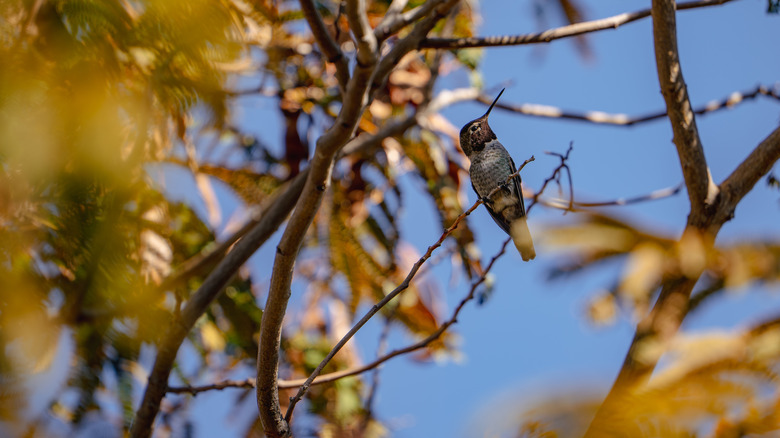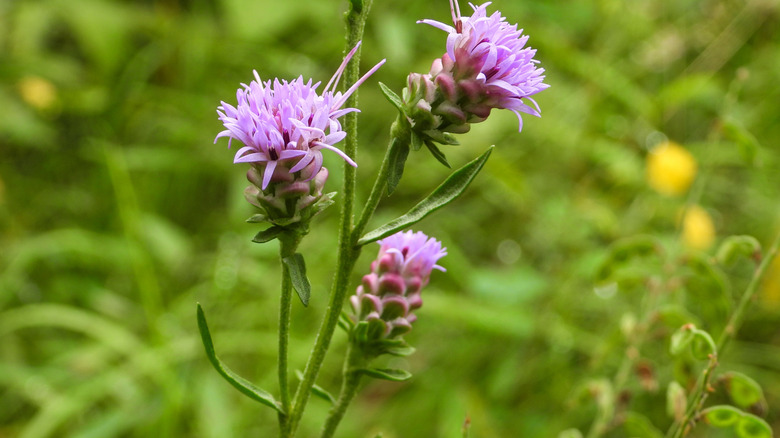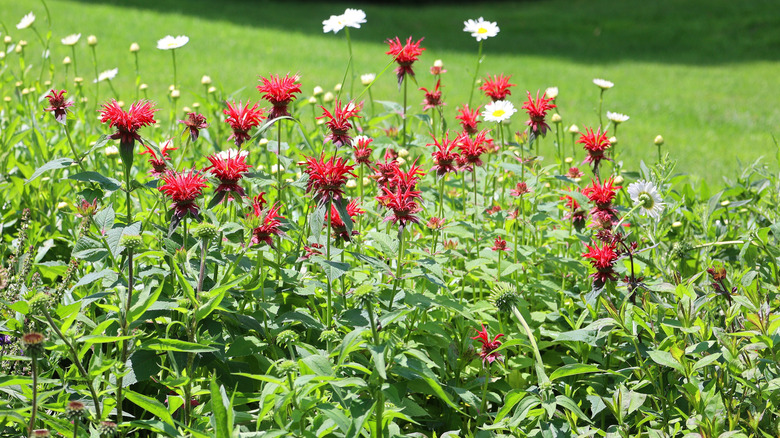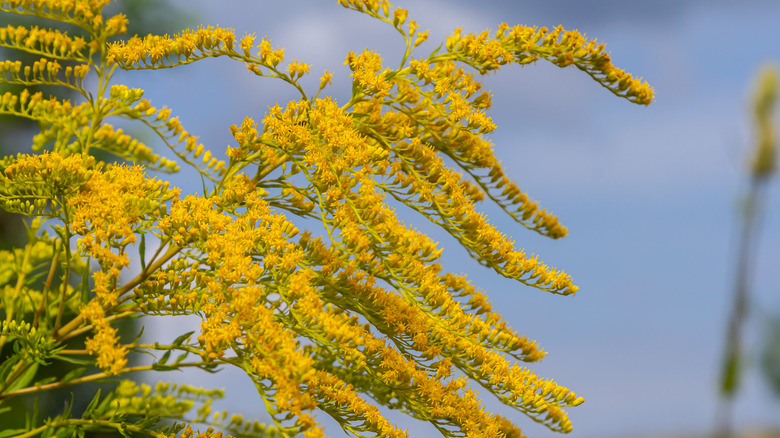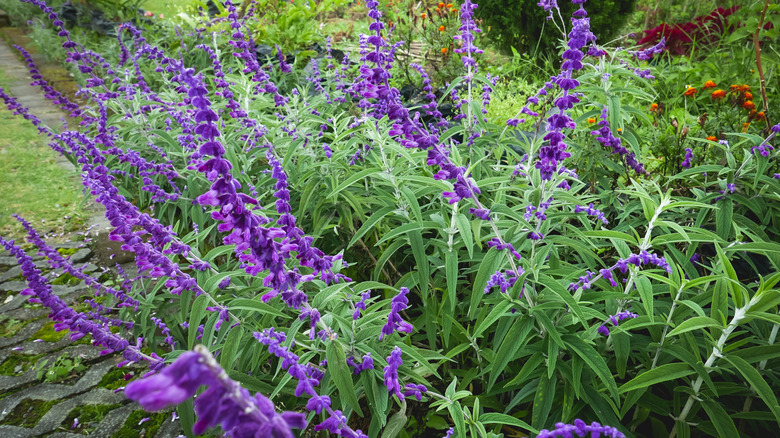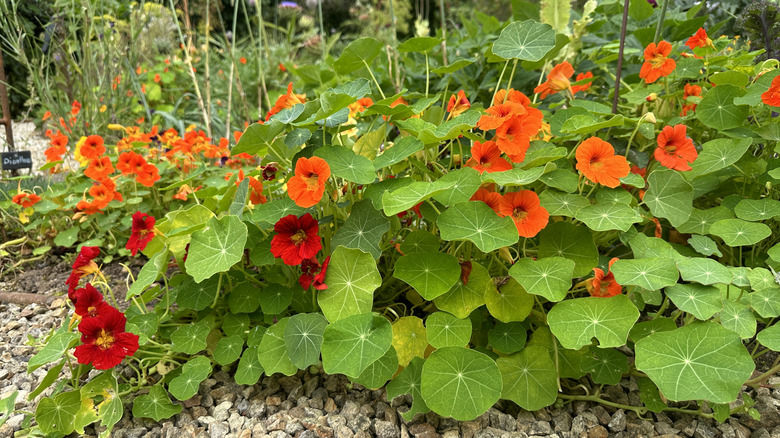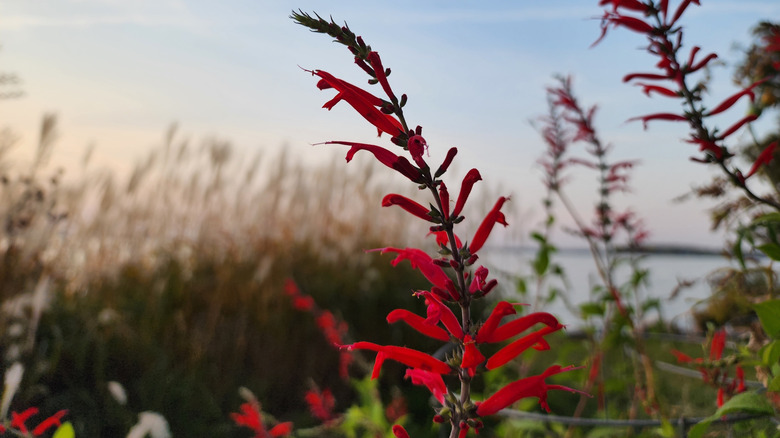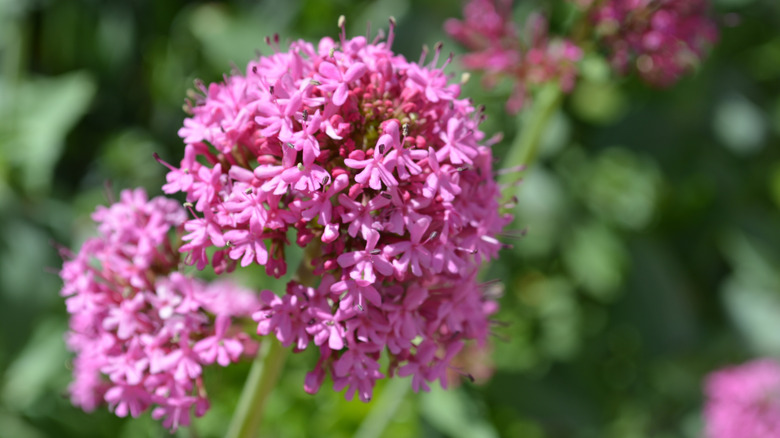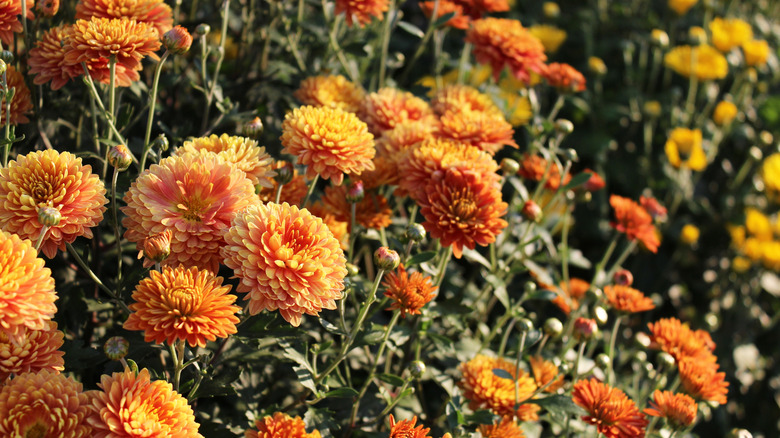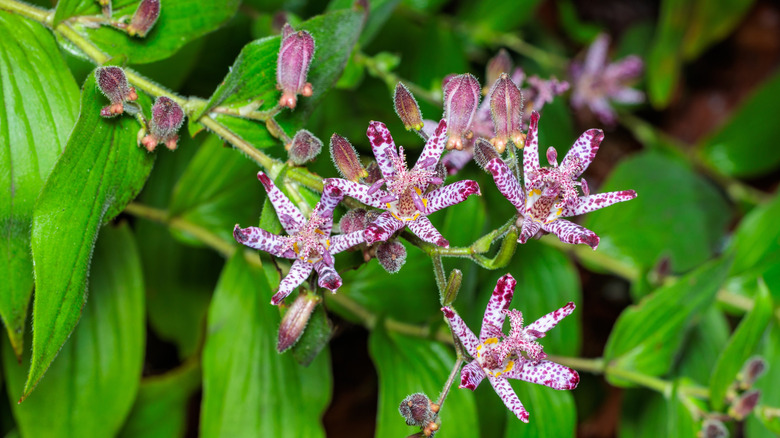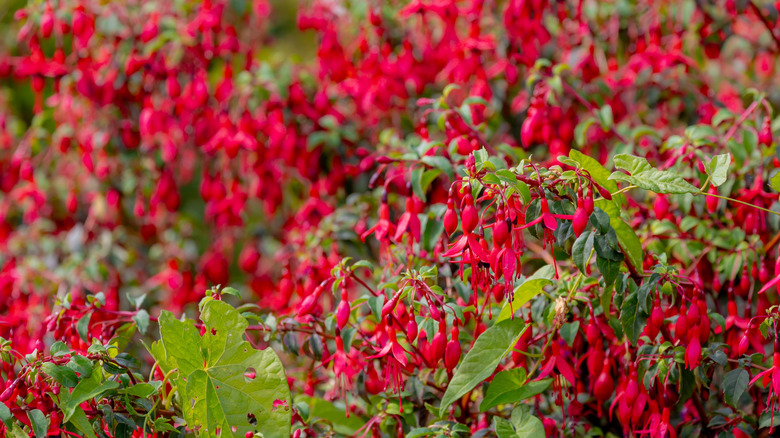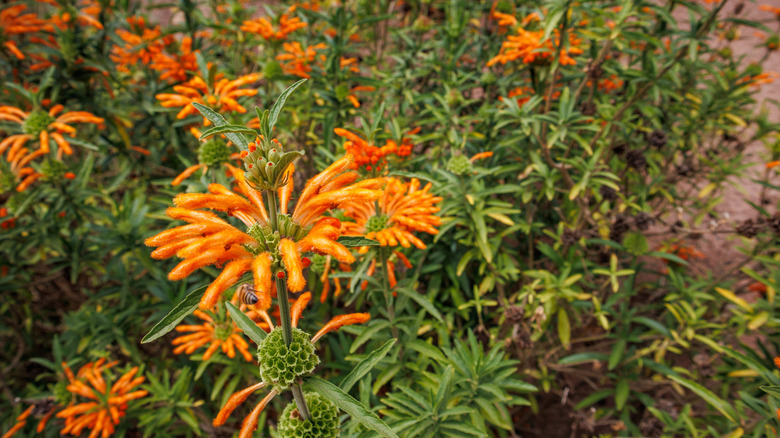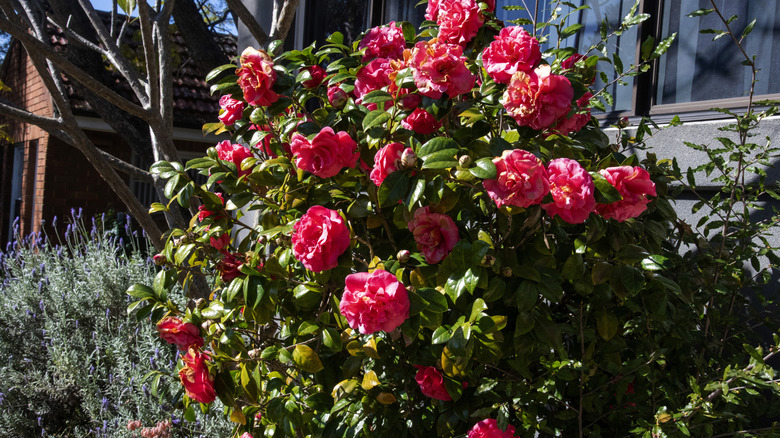12 Late Fall Blooming Flowers That Can Keep Hummingbirds Coming To The Garden
Just because the weather is cooling and the seasons are changing, doesn't mean we need to give up on festive blooms that attract friendly visitors to our garden. In fact, some delightful critters, like certain breeds of hummingbirds you'll see in cold weather, have adapted to chillier climates, surviving in the late falls and winters without migrating south. These hummingbirds go into a state of torpor — a version of hibernation that takes place daily rather than for long stretches of time — and when they wake up every day, they're hungry for a garden snack. A bevy of late-blooming flowers can sustain them through the cooler months while keeping your garden cheerful despite the brisk weather.
Among the blossoms, varieties like rough blazing star flowers (Liatris aspera) and Mexican sage (Salvia leucantha) bring vibrant, purple colors to otherwise dreary late-fall gardens, while other plants like nasturtium (Tropaeolum majus) contribute to a fall palette of oranges, reds, and yellows. These flowers don't just brighten the garden — they provide vital nectar sources when little else is in bloom. With a thoughtful mix of hardy, colorful species, you can keep your garden lively and welcoming for hummingbirds all fall long, heading into winter.
Rough blazing star
Rough blazing star flowers (Liatris aspera) produce clumping, lilac-colored blossoms beginning in the late summer and lasting into the cooler fall months. Hardy in USDA Zones 3 through 8, these flowers can grow up to five feet tall and are incredibly resilient across a wide range of climates. Their bottle-brush-like flowers are densely packed with tubular florets, a rich source of nectar for hummingbirds seeking a meal in autumn. Hummingbirds are naturally attracted to the tubed shape of the rough blazing star, making it a great pollinator-friendly addition to your late-season garden.
Bee balm
Known by many names, including bergamot, horsemint, and Oswego tea, bee balm (Monarda) is a member of the mint family. Hardy in Zones 4 through 9, it's known for its pollinator-friendly nature and variety of colorful blooms from summer to fall. Like its mint cousins, bee balm grows via underground rhizomes, making it easy to grow. Bee balm typically reaches heights of up to four feet with a spread of three feet. Popular colors include pink, purple, and red — all hues that hummingbirds are naturally attracted to when they seek their next nectar stash.
Goldenrod
A flower that blends seamlessly into fall color vibes, goldenrod (Solidago) actually describes an entire genus of herbaceous plants native to North America. All the varieties are known for their distinctive yellow or golden color, and they're all often summer and fall season bloomers. Hardy in Zones 2 through 8, goldenrod can grow to a staggering eight feet in height and is a favorite among bees, butterflies, songbirds, and hummingbirds alike. If you want to elongate their blooming season, try deadheading old flowers to promote additional blossoms.
Mexican bush sage
Mexican bush sage (Salvia leucantha) is a shrubby perennial that produces tall, velvety-to-the-touch flowers from late summer into fall. With some bushes reaching heights of six feet, these densely packed blooms are hardy in Zones 8 through 11, thriving in sunny locales. Their indigo-colored flowers are nectar and nutrient-rich, making them irresistible to hummingbirds seeking a steady food source through fall and into winter. As an added bonus, Mexican bush sage is both deer and rabbit-tolerant, meaning the tasty stuff is reserved for hummingbirds.
Nasturtium
Despite being native to warmer climates in South America, nasturtium (Tropaeolum majus) is hardy throughout Zones 2 through 11. It's easy to grow and provides blooms from summer into late fall. Though one of the most popular edible flowers for humans — similar to watercress in many ways — it's known to be toxic to dogs and cats, so best to leave them as a snack for the hummingbirds than your pets. Bushier varieties of this plant can reach up to a foot tall, while climbing varieties can reach heights of 10 feet.
Pineapple sage
Pineapple sage (Salvia elegans) is more mint than pineapple, but its fiery red, trumpet-shaped blossoms are just as sweet to hummingbirds as fruit. It earns its name from its scent — crush the leaves, and they release a pineapple-like aroma. A late summer into fall bloomer, pineapple sage is hardy in Zones 8 through 11. Undoubtedly, pineapple sage is incredibly attractive to hummingbirds for its color, flower shape, and nectar. Beyond its appeal to pollinators, pineapple sage adds a cheerful pop of color to autumn gardens, and the blossoms are also edible.
Jupiter's Beard
Jupiter's beard (Centranthus ruber), also known as red valerian, is a woody perennial with a long blooming season. It grows in dense, balled clusters of small, star-shaped flowers on top of thick stems. Thriving in full sun and well-drained soil, it's hardy in Zones 5 through 8 and can grow three or four feet tall. Its vivid pink, red, or white blossoms are rich in nectar and bloom from around May, well into the fall months, making them a favorite for hummingbirds and butterflies alike during colder weather and shorter days.
Chrysanthemums
The quintessential flower of fall-time festivities, chrysanthemums (Chrysanthemum) — also called mums — show off their beautiful warm-toned palettes going into the cooler months. You're hardly able to go to a grocery store without seeing mums for sale in the fall! Hardy in Zones 3 through 9, chrysanthemums can grow up to four feet tall. While not a typical favorite for hummingbirds, which prefer tubular blooms, chrysanthemums offer nectar when few other flowers remain. It's a classic flower variety that will attract hummingbirds, as well as butterflies, to your yard in fall.
Toad lily
The toad lily (Tricyrtis formosana) features unique, orchid-like flowers that bloom reliably in the late summer and into the fall. These plants are generally hardy in Zones 4 through 9 and typically grow to heights of up to three feet. Named for their spotted blossoms, which resemble a toad's back, these lilies attract hummingbirds and bees with sweet nectar. Just be wary that these plants do attract slugs and snails and can contract fungal disease, so be sure to keep toad lilies somewhat dry and avoid overwatering.
Fuchsia
Depending on the variety, fuchsia (Fuchsia) plants are prized for their continuous, long-lasting blooms from late spring until the first hard frost of fall. Hardier fuchsias can thrive in Zones 6 through 11, and they grow compactly in small, dense bushes up to three feet tall and just as wide. They grow in fairy tale-like, petite inverted bells, and their trumpeted flowers are the perfect shape for a hummingbird food source. A vibrant pinkish-red, fuchsias will add a beautifully whimsical pop of color to your fall garden.
Lion's tail
Also known as lion's ear, lion's tail (Leonotis leonurus) is a striking South African plant known for its velvety orange flower clusters. Hardy in Zones 8 through 11, it prefers tropical climates and while it does offer blooms into the later fall, it does not enjoy frost at all. o keep blooms thriving for hummingbird visitors (who love Lion's Tail nectar, by the way), be sure to bring these plants inside during the chillier nights if they're in containers.
Camellias
Another classic fall bloomer. sasanqua camellia (Camellia sasanqua) start their flowers in early fall and continues into late fall and early winter. They are a shrubby, woody perennial, but don't let that fool you — camellias of this variety can grow up to 14 feet in height in some cases. Hardy in Zones 7 through 9, they are a fall time favorite for hummingbirds, as these bushes and blooms provide much-needed shelter and winter nectar. With hues from cream to yellow to burgundy, camellias can brighten any fall garden.
